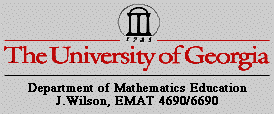
Lesson 1: Introducing two-dimensional shapes and terms
By: Tim Lehman

Before we can start any discussion on two-dimensional figures, the vocabulary to be used must be established. Definitions of shapes need to be agreed upon. These include (but are not limited to) circle, triangle, quadrilateral, trapezoid, parallelogram, rectangle, rhombus, square, pentegon, and other n-gons. Further, other terms used in later lessons such as acute, obtuse, right, scalene, isosceles, and equilateral triangle and regular should be discussed.
One method to establish the definition of the shapes is to present to students with examples and non-examples of a given figure. If these are chosen carefully, students can determine the proper definitions. Here are GSP sketches of examples and non-examples of trapezoids.
Other possible topics of exploration exist for this lesson. Some simply clarify definitions. Are squares always rectangles? Are rectangle always squares? The class can also discuss (and explore on GSP) questions with some more depth to them, such as: Can a right triangle have two right angles? What does a circle with an infinite diameter look like? Students may also find interesting the properties of centers of triangles (two examples here and here) or examine diagonals of different quadrilaterals (compare how diagonals intersect for rectangles, parallelograms, and squares, for example).